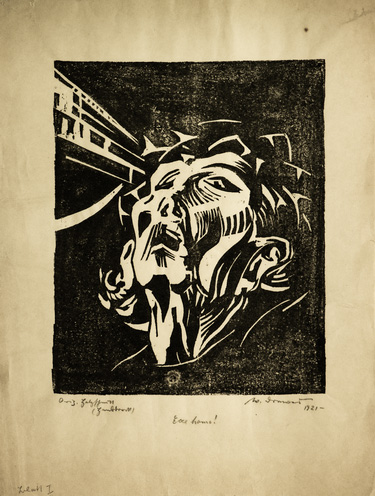Acquisition Number: 2024.5
Medium:
Woodcut on Japanese tissue
Size:
16 ? x 11 ? in.
Date:
1921
Credit: Gift of Thomas & Marsha French in memory of Thomas Horner
During the 1920s, Werner Drewes studied at the Bauhaus (Weimar) in Germany with various artists, including Lyonel Feininger who taught him to make woodblock prints. While at the Bauhaus, Drewes produced a portfolio of ten woodblock prints that explored the religious theme of Pontius Pilate's presentation of Jesus Christ to a hostile crowd ahead of his crucifixion. Titled "Ecce Homo," Latin for "Behold the Man," these were the words that Pilate spoke to the crowd after he witnessed Jesus's suffering and advocated for his release. "Ecce Homo I" is the first in the series of ten. Drewes' thematic choice for this series was influenced by his upbringing as the son of a Lutheran minister, who impacted Drewes' life outlook.
Drewes' "Ecce Homo" series demonstrates his skill in woodcut and ability to convey difficult narratives through abstraction. Bold lines and a stark contrast between black and white heighten the emotional intensity of the scenes. One of only few impressions before changes to the artist's monogram, this particular "Ecce Homo" was one of the few to be printed on Japanese tissue. The series is an important part of Drewes' artistic legacy, demonstrating the influence of German Expressionism on his interpretation of religious subjects.
|
